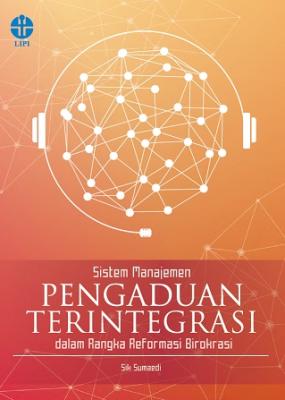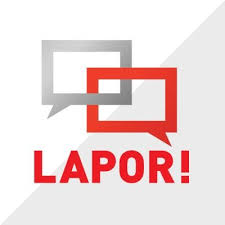Sistem Manajemen Pengaduan Terintegrasi dalam Rangka Reformasi Birokrasi
Keywords:
Manajemen Pengaduan, Reformasi BirokrasiSynopsis
Penulis: Sik Sumaedi
Dalam rangka meningkatkan kualitas pelayanan publik serta mewujudkan tata kelola pemerintahan yang baik, instansi pemerintah terus dituntut untuk melaksanakan dan mengembangkan program reformasi birokrasi. Salah satu program yang harus dijalankan adalah pengelolaan pengaduan. Dalam Permen PAN dan RB Nomor 1 Tahun 2015 tentang Pedoman Evaluasi Kinerja Penyelenggara Pelayanan Publik, salah satu komponen penilaian kinerja adalah pengelolaan pengaduan.
Pentingnya pengelolaan pengaduan bagi instansi pemerintah, sudah sepantasnya disikapi dengan serius dan konsisten. Akan tetapi, dalam pelaksanaan timbul beberapa pertanyaan terkait dengan sistem manajemen pengaduan pelanggan, seperti apakah yang harus diterapkan? Apa yang perlu dilakukan untuk menerapkan sistem manajemen pengaduan pelanggan tersebut? Hingga pada pertanyaan apa yang boleh ada dan tidak, agar sistem manajemen pengaduan pelanggan dapat sukses dalam mencapai tujuan?
Terbatasnya literatur mengenai pengetahuan untuk mengembangkan sistem manajemen pengaduan pelanggan yang sesuai dengan peraturan perundangan dan juga menerapkan praktik-praktik sistem manajemen pengaduan yang telah diakui dunia internasional memang belum ada. Untuk itulah, buku ini terbit sebagai salah satu kontribusi ilmiah guna menjawab pertanyaan-pertanyaan tersebut.
Buku ini dapat menjadi referensi yang tepat, khususnya bagi yang tertarik dengan topik pengelolaan pengaduan pelanggan, mulai dari praktisi seperti para pengambil kebijakan, pengelola pengaduan pelayanan, konsultan dan instruktur yang berhubungan dengan pengelolaan pengaduan; akademisi, seperti dosen, mahasiswa, dan peneliti dalam mengembangkan serta menerapkan sistem manajemen pengaduan yang efektif dan efisien dengan tetap mematuhi peraturan perundangan yang ada.
Copyeditor : M. Kadapi Layouter : Nurhasanah Ridwan dan Prapti Sasiwi Cover designer : Dhevi E.I.R. Mahelingga Registrasi : ISBN 978-979-799-859-2 Halaman : xviii + 175 hlm. Dimensi : A5 (14,8 x 21 cm)
©2016 Lembaga Ilmu Pengetahuan Indonesia (LIPI)
Downloads
References
Ajzen, I. (1991). e theory of planned behavior. Organizational Behavior and Human Decision Processes, 50(2), 179–211.
Bappenas. (2010). Manajemen Pengaduan Masyarakat dalam Pelayanan Publik. Jakarta.
Bearden, W.O., & Mason, J.B. (1984). An investigation of in uences on con- sumer complaint reports. Advances in Consumer Research, 11, 490–495.
Beckmerhagen, I., Berg, H., Karapetrovic, S., & Willborn, W. (2003). In- tegration of management systems: focus on safety in the nuclear industry. International Journal of Quality & Reliability Management, 20(2), 209–227.
Bernardo, M., Casadesus, M., Karapetrovic, S., & Heras, I. (2012). Do in- tegration di culties in uence management system integration levels? Journal of Cleaner Production, 21, 23–33.
Bernardo, M., Casadesus, M., Karapetrovic, S., & Heras, I. (2010). An em- pirical study on the integration of management system audits. Journal of Cleaner Production, 18, 486–495.
Bernardo, M., Casadesus, M., Karapetrovic, S., & Heras, I. (2011). Rela- tionships between the integration of audits and management systems: An empirical study. e TQM Journal, 23(6), 659–672.
Bernardo, M., Casadesus, M., Karapetrovic, S., & Heras, I. (2009). How in- tegrated are environmental, quality and other standardized management systems? An empirical study. Journal of Cleaner Production, 17, 742–750.
Brennan, C., & Douglas, A. (2002). Complaint procedures in local govern- ment, informing your customers. e International Journal of Public Sector Management, 15(3), 219–236.
Dabholkar, P.A. (1994). Incorporating choice into an attitudinal framework: analyzing models of mental comparison processes. Journal of Consumer Research, 21, 100–118.
David, F.R. (2003). Strategic management: Concepts and cases (9th ed). New Jersey: Prentice Hall.
Day, R.L. (1984). Modeling choices among alternative responses to dissat- isfaction. Advances in Consumer Research, 11, 496–499.
Desatnick, R.L., & Detzel, D.H. (1993). Managing to keep the customer: How to achieve and maintain superior customer service throughout the organization. San Francisco, CA: Jossey-Bass Publishers.
Filip, A. (2013). Complaint management: A customer satisfaction learning process. Procedia Social and Behavioral Sciences, 93, 271–275.
Fornell, C., & Didow, M.D. (1980). Economic constraints on consumer complaining behavior. Advances in Consumer Research, 7, 318–323.
Fornell, C., & Wernerfelt, B. (1987). Defensive marketing strategy by custom- er complaint management: a theoretical analysis. Journal of Marketing Research, 24, 337–346.
Fornell, C., & Wernerfelt, B. (1988). A model for customer complaint management. Marketing Science, 7(3), 287–298.
Fornell, C., & Westbrook, R.A. (1984). e vicious circle of consumer complaints. Journal of Marketing, 48, 68–78.
Goodman, J. (1999). Basic facts on customer complaint behavior and the impact of service on the bottom line. Competitive Advantage, 1–5.
Gri n, R.W. (2002). Management (7th ed). Boston, MA: Houghton Mi in Company.
Gronroos, C. (1984). A service quality model and its marketing implications. European Journal of Marketing, 18(4), 36–44.
Hart, C.W.L., Heskett, J.L., & Sasser, W.E. (1990). e pro table art of service recovery. Harvard Business Review, 68, 148–156.
Hoyle, D. (2009). ISO 9000 quality system handbook, using the standards as a framework for business improvement (6th ed). Burlington, MA: Butterworth-Heinemann.
Hughes, S., & Karapetrovic, S. (2006). ISO 10002 complaints handling system: A study. International Journal of Quality & Reliability Man- agement, 23(9), 1,158–1,175.
ISO. (2005). ISO 9000. Quality management systems–fundamentals and vocabulary. Geneva: ISO.
ISO. (2014). ISO 10002, quality management: Customer satisfaction–guidelines for complaints handling. Geneva: ISO.
Jacoby, J., & Jaccard, J.J. (1981). e sources, meaning, and validity of consumer complaint behavior: A psychological analysis. Journal of Retailing, 57(3), 4–24.
Jørgensen, T.H., Remmen, A., & Mellado, M.D. (2006). Integrated manage- ment systems–three di erent levels of integration. Journal of Cleaner Production, 14, 713–722.
Jørgensen, T.H. (2008). Towards more sustainable management systems: through life cycle management and integration. Journal of Cleaner Production, 16, 1,071–1,080.
Karapetrovic, S., & Jonker, J. (2003). Integration of standardized management systems: search for a recipe and ingredients. Total Quality Management and Business Excellence, 14(4), 451–459.
Karapetrovic, S., & Willborn, W. (1998). Integration of quality and envi- ronmental management systems. e TQM Magazine, 10(3), 204–213.
Kim, C., Kim, S., Im, S., & Shin, C. (2003). e e ect of attitude and perception on consumer complaint intentions. Journal of Consumer Marketing, 20(4), 352–371.
Kotler, P., & Keller, K.L. (2012). Marketing management (14th ed). Englewood Cli s, NJ: Prentice Hall.
Labodova, A. (2004). Implementing integrated management systems using a risk analysis based approach. Journal of Cleaner Production, 12, 571–580.
Lerman, D. (2006). Consumer politeness and complaining behavior. Journal of Services Marketing, 20(2), 92–100.
Liu, R.R., & McClure, P. (2001). Recognizing cross?cultural di erences in consumer complaint behavior and intentions: An empirical examination. Journal of Consumer Marketing, 18(1), 54–75.
Oh, D.G. (2003). Complaining behavior of public library users in South Korea. Library & Information Science Research, 25, 43–62.
Oh, D.G. (2004). Complaining behavior of academic library users in South Korea. e Journal of Academic Librarianship, 30(2), 136–144.
Oliver, R.L. (1980). A cognitive model of the antecedents and consequences of satisfaction decisions. Journal of Marketing Research, 17(4), 460–469.
Parasuraman, A., Zeithaml, V.A., & Berry, L.L. (1988). SERVQUAL: A multi-item scale for measuring consumer perceptions of the service quality. Journal of Retailing, 64(1), 12–40.
Parasuraman, A., Zeithaml, V.A., & Berry, L.L. (1994). Reassessment of expectations as a comparison standard in measuring service quality: implications for further research. Journal of Marketing, 58, 111–124.
Pattiro. (2015). Laporan pengkajian penguatan mekanisme komplain P5 Kota Semarang. Retrieved from http://pattirosemarang.org/2015/03/lapo- ran-pengkajian-penguatan-mekanisme-komplain-p5-kota-semarang.html
PIRAC. (2014). Studi efekti tas dan responsivitas pelayanan pengaduan (Complaint Mechanism) masyarakat berbasis IT pada LAPOR! Retrieved from (www.lapor.ukp.go.id).
Sahin, A. (1997). Customer complaints management and empowerment. 4th International Management Conference, 1–14.
Salomone, R. (2008). Integrated management systems: Experiences in Italian organizations. Journal of Cleaner Production, 16, 1,786–1,806.
Singh, J. (1988). Consumer complaint intentions and behavior: De nitional and taxonomical issues. Journal of Marketing, 52(1), 93–107.
Soares, R.V.R.S.F. (2014). Service recovery paradox: Customers’ response to a service failure-recovery situation in a mobile telecommunications context (Ph.D. Dissertation in Business and Management Studies). University of Porto.
Stichler, J.F., & Schumacher, L. (2003). e gi of customer complaints. Marketing Health Services, 23(4), 14–15.
Sumaedi, S., Bakti, I.G.M.Y.B., Rakhmawati, T., Astrini, N.J., Widianti, T., & Yarmen, M. (2014). e empirical study on patient loyalty: e role of trust, perceived value, and satisfaction (A case study from Bekasi, Indonesia). Clinical Governance: An International Journal, 19(3), 269–283.
Sumaedi, S., & Rakhmawati, T. (2015). e e ect of system design type on ISO 9001 implementation outcome: A proposed conceptual framework and future research agenda. International Journal of System Assurance Engineering and Management, 1–11.
Surbekti, D.S.M.P. (2013). Manajemen komplain pelanggan dalam rangka peningkatan pelayanan di RSUD Dr. Iskak Tulungagung. Kebijakan dan Manajemen Publik, 1(1), 47–55.
Tax, S.S., & Brown, S.W. (1998). Recovering and learning from service failure. Sloan Management Review, 40(1), 75–88.
omson, A.A., Peteraf, M.A., Gamble, J.E., & Strickland III., A.J. (2012). Cra ing and executing strategy: e quest for competitive advantage–con- cepts and cases (18th ed). New York: McGraw-Hill/Irwin.
Tronvoll, B. (2012). A dynamic model of customer complaining behaviour from the perspective of service-dominant logic. European Journal of Marketing, 46(1/2), 284–305.
Utomo, S.D. (2008). Penanganan pengaduan masyarakat mengenai pelayanan publik. Jurnal Ilmu Administrasi dan Organisasi, 15(3), 161–167.
Widianti, T., & Damayanti, S. (2015). Analisis SWOT: Strategi pengembangan kelompok penelitian. Paper presented at Seminar Annual Meeting on Testing and Quality (AMTeQ), Serpong.
Zeithaml, V. (1988). Consumer perceptions of price, quality and value: a means and model and synthesis of evidence. Journal of Marketing, 52, 2–22.
Zeithaml, V., & Bitner, M.J. (2003). Service marketing: Integrating customer focus across the rm (3rd ed). Boston: McGraw Hill.
Zeithaml, V., Bitner, M.J., & Gremler, D. (2009). Services marketing: Inte- grating customer focus across the rm (5th ed). Boston: McGraw-Hill.
Zeng, S.X., Shi, J.J, & Lou, G.X. (2007). A synergetic model for implement- ing an integrated management system: An empirical study in China. Journal of Cleaner Production, 15, 1,760–1,767.
Zeng, S.X., Tam, V.W.Y., & Le, K.N. (2010). Towards e ectiveness of integrated management systems for enterprises. Inzinerine Ekonomika-Engineering Economics, 21(2), 171–179.

Downloads
Published
Series
Categories
License

This work is licensed under a Creative Commons Attribution-NonCommercial-ShareAlike 4.0 International License.






























